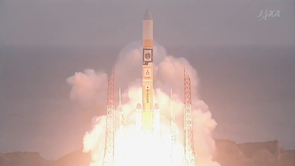Liftoff for ASTRO-H, now in orbit as Hitomi
17 February 2016
JAXA's ASTRO-H satellite was launched earlier today on an H-IIA rocket from the Tanegashima Space Center, situated on a small island in the south of Japan. This space-borne observatory, developed in collaboration with institutions in Japan, the US, Canada and Europe, will probe the sky in the X-ray and soft gamma ray portions of the electromagnetic spectrum.
 |
| Launch of ASTRO-H. Credit: JAXA |
The rocket lifted off at 08:45 GMT (09:45 CET) on 17 February and, approximately 14 minutes and 15 seconds after liftoff, separation of the satellite was confirmed. JAXA confirmed that the satellite has deployed its solar array paddles normally through data transmitted from the satellite and received at the Uchinoura Ground Station.
Traditionally, Japan's astronomy satellites receive a provisional name during the implementation phase, and are then renamed after launch.
The now in-orbit ASTRO-H satellite received its new designation today: Hitomi, a Japanese word used to describe the 'eye', and more specifically the pupil, or entrance window of the eye. The name Hitomi, which is also linked to an ancient legend about a painter drawing dragons, is a fitting description for this satellite that will be a new eye to study the hot and energetic Universe.
A high-energy observatory, Hitomi is designed to study some of the most powerful phenomena in the cosmos, ranging from supernova explosions at the end of a star's life to supermassive black holes devouring matter at the centre of distant galaxies, and the hot gas permeating galaxy clusters, the largest bound structures in the Universe.
ESA contributed to the mission by partly funding various elements of the four science instruments, by providing three European scientists to serve as science advisors and by contributing one scientist to the operations team in Japan. In return for ESA's contribution, European scientists will be able to compete for about 8% of the observational time.
For more information, please contact:
Peter Kretschmar
ASTRO-H ESA Development Manager
Directorate of Science
European Space Agency
Email: Peter.Kretschmar![]() esa.int
esa.int
Tel: +34 918 131 399
Matteo Guainazzi
ASTRO-H ESA Science Operation Centre
and ASTRO-H JAXA Science Operation Team
Institute of Space and Astronautical Science, Japan
Email: mguainaz![]() astro.isas.jaxa.jp
astro.isas.jaxa.jp

